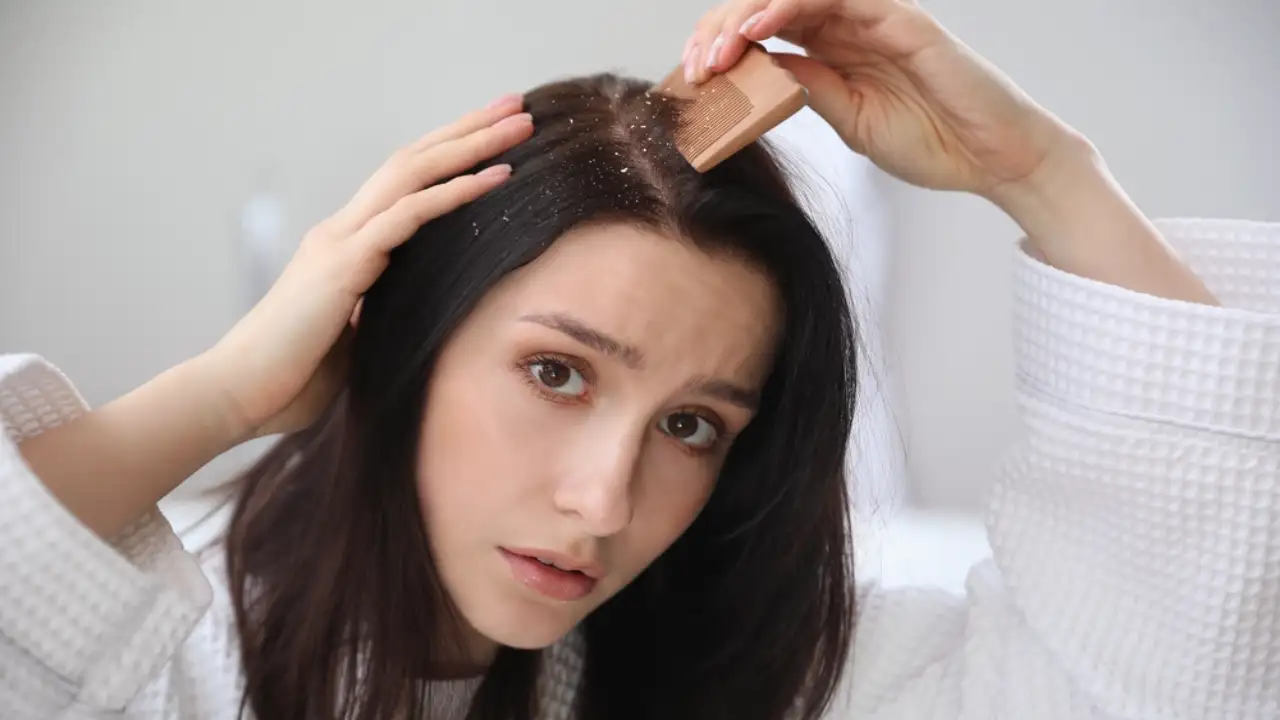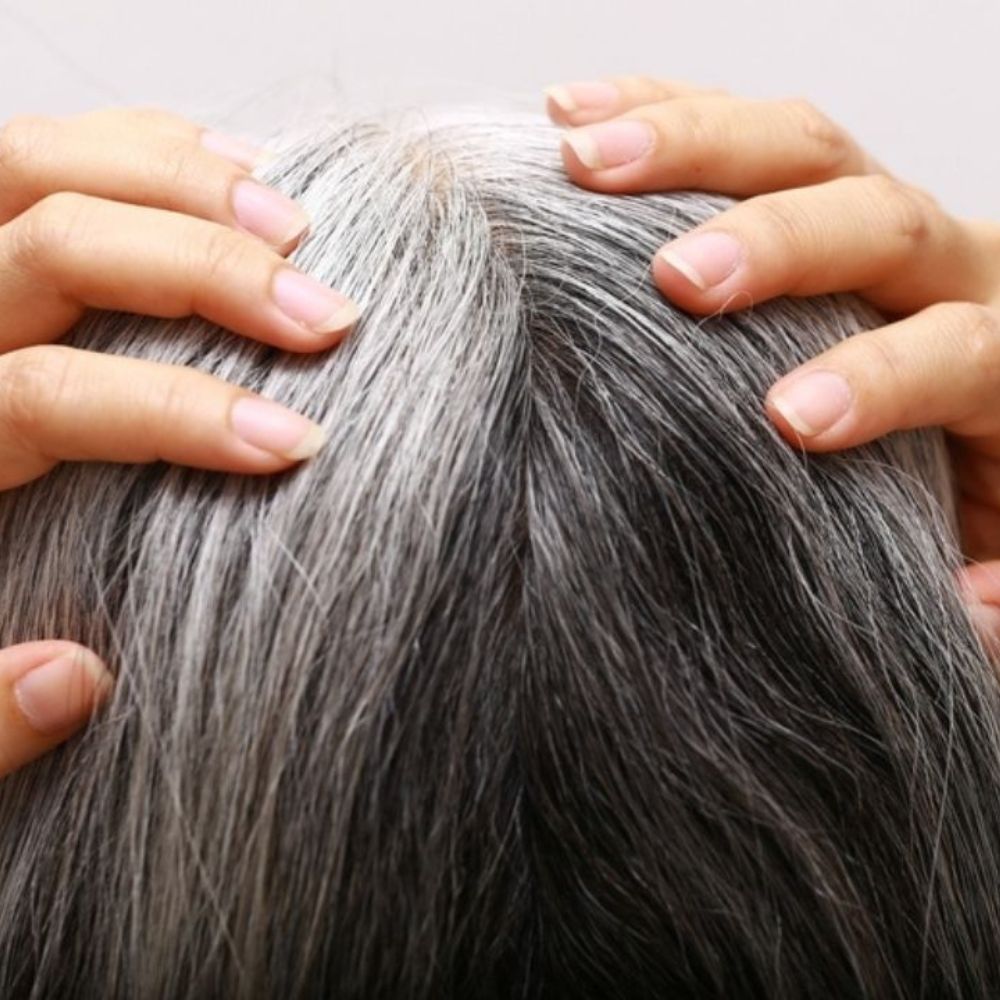What Is Wet Dandruff? Here’s a Breakdown of Its Causes, Treatment, And Prevention
Are you suffering from an itchy scalp and greasy hair? These are signs of wet dandruff. In this article, find everything you need to know about navigating it.

Trendy highlights, fresh blowouts, and a new haircut that adds volume — it’s a no-brainer that your hair is an extension of your personality. Hair may make or break your overall look. But due to environmental factors and a dynamic lifestyle, sometimes it may be tricky to keep your mane healthy and fresh. What’s even worse is when you find dandruff sneaking up on your tresses and shoulders. Are you questioning why is my scalp wet after scratching? You may have become a victim of wet dandruff. It can feel challenging to deal with wet dandruff on the scalp, but treating it is really important, as dandruff can result in various problems, including scalp infections, hair loss, irritation, baldness, and so on (1).
It is very important to treat dandruff as this can serve as the root cause of other serious hair problems like hair fall, baldness, scalp infection, alopecia, to name but a few.
What Is Wet Dandruff?
Dandruff is a common hair concern that affects everyone globally regardless of age, gender, and ethnicity (1). This familiar skin problem has various types and hence, has distinct treatments to combat it.
If you have been getting a sensation of a moist scalp or getting a feeling of an itchy wet scalp, then chances are that you are suffering from wet dandruff. The sebaceous glands in your scalp are responsible for producing sebum (the natural oil in hair) which keeps your tresses hydrated and nourished (2). It also helps tame frizz and make hair more manageable.
However, when these glands produce an excess of sebum, it often leads to a greasy scalp. As a result; external dirt, grime particles, and dead skin cells start getting attracted to this sticky scalp which may cause a buildup on your scalp. Eventually, this dirt forms a layer on the scalp which may feel itchy and wet. This is known as wet dandruff and it may cause a moist flaky scalp (3).
What Is the Difference Between Wet Dandruff and Dry Dandruff?
Differentiating between wet and dry dandruff may be tricky. But here’s what you need to know: a clear line may be drawn between both after examining and understanding the sebum production level in hair (4). Dry dandruff often constitutes white flakes which are typically small in size and fall off from hair with movement. This type of dandruff may not cause any redness or inflammation on the scalp and is generally not long-lasting (1), (3).
While on the other hand, wet dandruff is yellow and causes a buildup of dirt on your scalp (1), (2), (3). This kind of dandruff is sticky and may create large flakes on your scalp which might attract more dirt and grime. Do you feel a sticky liquid coming from your scalp? It might be an adverse effect of this type of dandruff. Further, this common hair problem may also cause a wet flaky scalp which might feel irritating and itchy over time.
What Are the Common Causes of Wet Dandruff?
Itchy scalp when wet may be troublesome to handle. But if you understand the causes of this hair and skin problem, it might get easier to navigate and combat it. Ahead, we have put together the common causes of wet dandruff which you should know:
Changes in Your Hormones
Dandruff is a common hair problem that may start from a prepubertal age (1). As you grow up, you undergo hormonal changes and imbalances which are often triggered by factors such as stress, anxiety, PCOD, and more. Due to the changes in hormones, the body may start producing excess sebum. Eventually, this results in an oily, wet scalp that may start attracting dirt and grime particles (2), (5)..
Shampooing Your Hair in an Irregular Manner
Dandruff or no dandruff, it is imperative to shampoo your hair regularly to ensure its health, nourishment, and appearance. When you don’t shampoo your tresses properly, you may invite unwanted hair problems. One of these problems may be wet dandruff which may start accumulating as an oily buildup on your scalp, if not removed (1), (6).
Having an Oily Skin And Scalp
When the sebaceous glands in your body produce excessive sebum, it may lead to oily skin and greasy hair. This situation might cause the accumulation of yellow stuff in hair which comprises external dirt, grime particles, and dead skin cells. Over time, oily skin and scalp may lead to the creation of buildup which may eventually turn into wet dandruff (1), (2), (3). To avoid a wet dandruff scalp, it is important to ensure that hair and scalp don’t get too oily for dirt to thrive on it.
A Guide to Getting Dandruff out of Wet Hair

Tackling dandruff may be difficult and tricky to handle — especially when it accumulates on an oily scalp. Have you been wondering how to get rid of yellow dandruff easily? Luckily, some natural remedies may help you combat this type of dandruff. Ahead, we have put together the ultimate beauty edit of three ingredients that may help fight wet dandruff on the scalp effectively.
Baking Soda
Baking soda (or sodium bicarbonate) might seem like an unconventional method to get rid of dandruff but it may prove to work wonders for your scalp. Research suggests that baking soda has antifungal properties which inhibit fungal growth in humans (7). Hence, using this ingredient can help you combat superficial infections such as wet hair dandruff.
Method: Mix three tablespoons of baking soda with some water and mix it properly to form a paste. Once you get a well-combined mixture, apply it to your scalp, and leave it on for about 10 minutes. After it has dried up, wash your hair with your usual shampoo and conditioner.
Aloe Vera

Aloe vera can help you with wet dandruff treatment. Best known for its medicinal, skincare, health, and beauty properties — Aloe Vera has been in use for centuries in several cultures. The gel of this plant is packed with cleansing elements such as catalase, oxidase, amylase, and vitamins B, C, and E. It has anti-inflammatory properties which might help provide relief from the itchiness and soothe the redness on the scalp. Research suggests that the Aloe Vera gel may prove to display anti-dandruff activity by hampering the microbial growth that is associated with wet dandruff formation (8), (9).
Method: Apply the Aloe Vera gel all over your scalp properly. Then, use a damp towel (dipped in hot water) and wrap it around your head. This will enhance the process and help your scalp absorb the gel completely. After about 30 minutes, rinse your hair with regular shampoo and conditioner.
Apple Cider Vinegar
Apple cider vinegar is an amber-colored vinegar obtained from apples that may help in combating a wet itchy scalp. Research suggests that apple cider vinegar may work as a natural antifungal agent that might help in hampering the growth of a dandruff-causing fungus called Malassezia furfur. Hence, using this ingredient may diminish or decrease the appearance of dandruff on hair and scalp. It may also be considered an economical and natural shampoo because it may get rid of residue on your scalp and hair shafts. Additionally, apple cider vinegar might benefit your hair even further by making it smoother, shinier, and silkier (10).
Method: The process of using apple cider vinegar to combat wet scalp dandruff is simple. All you need to do is take half a cup of the product and pour it all over your scalp. Then, massage it for about 10 minutes until it is fully absorbed. Finally, rinse your hair with your usual shampoo and conditioner with a mild formulation. You may repeat this routine once a week.
Tips to Keep in Mind for Fighting Wet Dandruff
While wet dandruff treatment using natural remedies may help you get rid of the itchiness and unpleasant flakes, your effort shouldn’t stop there. Here are some additional tips to keep in mind for combatting wet dandruff effectively and efficiently:
Choose the Right Shampoo And Conditioner
It is imperative to pick the right shampoo and conditioner when fighting dandruff. Studies state that you may opt for products that contain active ingredients such as salicylic acid, urea oil, selenium, tar, sulfur, and zinc. These elements may help to soften the flakes on the scalp which eventually fall off while washing. You may also choose shampoos with antifungal formulations (1), (6).
Shampoo Regularly
If you do not shampoo and condition your hair on a regular schedule, then it might result in a moist scalp. This may happen as the sebum on your hair will start accumulating over time and attract dirt to it, causing major wet dandruff flakes. Hence, to fight dandruff, it is important to keep your hair and scalp clean by shampooing regularly (1), (2), (6).
Refrain from Using Heat Styling and Chemical Treatments
When your scalp and hair are already combatting and healing from dandruff, it is wise to not irritate it further. Hence, try avoiding heat styling and chemical treatments on your hair which might cause further damage to your mane. While heat may make your hair rough, chemical treatments may damage your hair shaft permanently (11).
Follow a Healthy Diet
Studies have showcased that following a healthy diet may help in preventing common hair problems such as seborrheic dermatitis. You may limit your junk food intake and replace this oily food with whole fruits and vegetables. Maintaining a diet that is high in fruits and vegetables may help in clearing the buildup from your scalp and hence combating dandruff naturally (12).
How Does Wet Dandruff Appear on Eyelashes and Eyebrows?
If you are suffering from wet hair dandruff, it may be highly likely that you are prone to oily skin caused due to excessive sebum production in your body. Factors like hormonal changes, stress, anxiety, PCOD, or more may trigger the sebaceous glands to produce natural oil.
As a result, the skin around your eyelashes and eyebrows might become oily which may further attract external dirt, grime particles, dead skin cells, and more. Hence, wet dandruff may appear on the area around your eyelashes and eyebrows (1), (2), (5).
Home Remedies to Get Rid of Wet Dandruff from Eyelashes And Eyebrows
Below are some ways to eliminate dandruff and strengthen hair follicles:
1. Neem Oil
The excellent antifungal properties of neem leaves help fight the fungus that causes dandruff. Besides, it also contains essential vitamins and nutrients that offer nourishment to the eyelashes and boost skin health (13).
Apply neem oil on your eyelashes and eyebrows, making sure it doesn’t get into your eyes. Leave it be for 2-3 hours, then rinse it off with lukewarm or slightly cool water.
2. Aloe Vera And Tea Tree Oil
Aloe vera is considered a boon by many, owing to its various properties that keep our skin, hair, and overall body healthy. It has antifungal and antibacterial properties that inhibit the production of fungus, thereby preventing the onset of dandruff (14). Tea tree oil too with its potent antifungal properties helps treat dandruff (15).
Mix one tablespoon of aloe vera gel with 4 drops of tea tree oil and apply to your eyelashes and eyebrows. Massage gently and rinse it off after an hour.
Over-the-Counter Treatments for Dandruff
Some of the popular OTC treatments for dandruff include using anti-dandruff shampoos. Some people also go for medicated shampoos and conditioners to get rid of dandruff stuck to hair. However, if the symptoms persist, it’s important to visit a professional and solve the problem with the help of prescription shampoos and medication, if required.
Conclusion
If you have been asking yourself why is my scalp wet after scratching, then it is highly likely that you are suffering from wet dandruff. This type of dandruff may be tricky to combat as it forms a layer of dirt on your hair and scalp. It may make your scalp oily, and might also cause redness and inflammation which might be troublesome to handle. Distinct factors like not shampooing regularly, excessive sebum production, and hormonal changes may cause this sticky dandruff to grow and thrive.
However, you may rely on natural remedies and other chemical formulations to help get rid of this common hair problem. These solutions may loosen and soften dandruff which might let it fall off easily while washing. So, while this type of dandruff may seem difficult to navigate, with the right information at your disposal you may combat it easily.





 JOIN OUR WHATSAPP CHANNEL
JOIN OUR WHATSAPP CHANNEL






















































